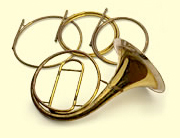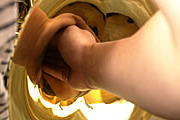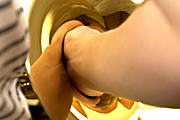How to Play the Horn
The biggest mystery of the horn-putting the right hand in the bell
Changing the pitch with the right hand
In contrast to the modern horn, the natural horn originally had no bell, and the only way to change the pitch was by changing the speed with which air was blown into the instrument. As a result, the notes that were emitted were limited to natural harmonics. C, G, C, E, G, B♭-horn players jumped around this arrangement of notes, and they could not play a phrase that included D or F. What changed all that was the hand-stopping technique.

A natural horn-which only produces natural harmonics-and crooks, which are replacement pipes to change the pitch

Natural harmonics of brass instruments
The hand-stopping technique was devised as a solution to playing notes that were not natural harmonics. Hand-stopping entails controlling the pitch by inserting the right hand into the bell in varying degrees. This technique includes the full-stop and the half-stop, and it was made popular by Bohemian horn player A. J. Hampel in the mid-eighteenth century. Hand-stopping can change a note by a semitone or whole tone up or down, and thus makes it possible to play chromatic music on a natural horn.

Is hand-stopping just a relic from the past?
Hand-stopping is no longer necessary to produce semitones because the horn has valves now. However, hand-stopping is still used today to support the instrument and to make minor adjustments to the pitch or timbre.
For example, playing the F horn slightly stopped with the right hand produces a tone called half-mute: a muddled, warm timbre that is a semitone lower than the note on the music.
What is the hand-stopping technique?
Using the right hand to completely seal off the bell increases the pressure of the air blown into the instrument, and a keen metallic tone about a semitone higher is produced. This is called hand-stopping, and it is used to create a certain mood in a song. Hand-stopping is indicated by a "+".

The "+" symbols in the second movement of Rimsky-Korsakov's Capriccio Espagnol. The "0" symbol tells the player to return to the "open hand-stop" (normal state).
In terms of physics, the hand-stopping technique raises the pitch to a little above the next lower harmonic, but in terms of music, it is probably easier to think of it as raising the pitch.
When blowing normally, hand-stopping will raise the pitch of the F tube by a semi-tone, and the B♭tube by a two-thirds tone.
Some horns have a gesttopft key, which lowers the pitch by the same amount that it rises. Horns with this key can play the note indicated on the score, but those that do not have this key must play a semitone lower when hand-stopping.

The hand in the normal position

An example of hand-stopping
The F tube pitch raised a semi-tone by hand-stopping
Musical Instrument Guide : Horn Contents
Origins
Structure
How to Play
How the Instrument is Made
Choosing an Instrument
Trivia
- Famous horn works
- Concertos
- Mesmerizing fifths
- What does a very long horn sound like?
- The visual effect of "bells up"
- Mozart loved a good prank
- Is that the nature of the horn?
- An instrument by day, and a drinking mug by night
- Horn players can play the Wagner tuba, despite the name
- Why are horns included in woodwind quintets?
- What do you call someone who plays a horn?
- The reason that alto horns are used in brass bands
- What is a Vienna horn?
- Garlands do not deaden sound
- What is the Knopf model?
- New instruments have just been washed
